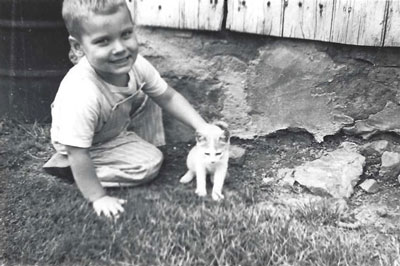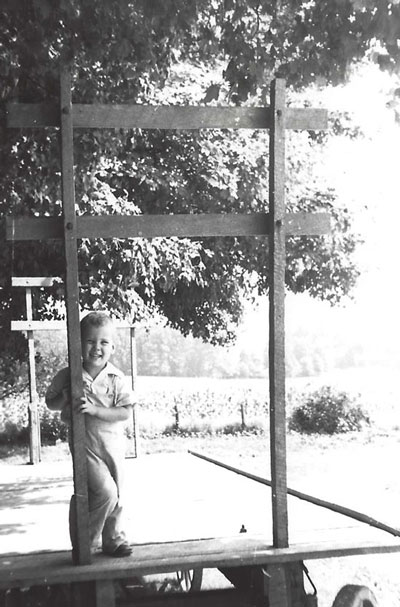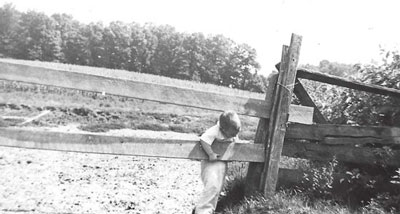In My Life and in Trump’s Life
This article is about two people I knew during my journey down the yellow brick road of life, and how they haunt me today. The first was my Uncle Walter, who owned a dairy farm near Oxford, PA. My mother’s side of the family was brought up as Quakers. Her mother had two cousins, Laura and Ethel, who were the children of Uncle Walter.
Each summer, my parents would drive our family down to the farm. Talk about paradise. These three photos of me as a toddler playing with Green Eyes, me on the hay wagon, and opening the gate to the pasture for the cows.



Uncle Walter accidentally fell off the roof of the barn while he was re-shingling it. His accident occurred when he was in his mid-80s. However, when my parents took me down to the farm, one of my jobs was to play Chinese Checkers with him. Essentially, I was babysitting as a four or five-year-old kid for Uncle Walter on the front porch. I took that responsibility seriously and tried to explain to Uncle Walter how to play the game.
Then, Uncle Walter put a marble into his mouth while we played Chinese Checkers. I politely told him that he shouldn’t do that, but he ignored me. Suddenly, I looked at Uncle Walter and screamed, “Uncle Walter’s mouth is melting.” The adults inside the house heard my yell and rushed out to the porch. They realized that his upper set of false teeth and the marble had fallen out of his mouth. The adults merely said that Uncle Walter was getting old and assured me that his mouth wasn’t melting.
The other person is a family member who is dealing with dementia in a nursing home. This person’s dementia and life are in the final stages. Family members are suffering more than the person.
Now, I assume that Uncle Walter and the family member suffered from Alzheimer’s. Part of my problem is that there are various forms. I went to the Internet to find out if my diagnosis was correct. In the process, I came across an interviewer for the Daily Beast who had interviewed Dr. John Gartner. When I saw his name, I was fascinated.
I recalled that Dr. Gartner edited a book written by a couple of dozen psychiatrists and psychologists nearly a decade ago, entitled The Dangerous Case of Donald Trump. Even more interesting was that the interview was done less than a month ago. Our TACO President has frontotemporal dementia. I was really into Gartner’s explanation of his diagnosis of Trump.
This is Gartner’s observation.
Gartner’s baseline is something of which I wasn’t aware. Dementia is with people who start with normal behavior and then, over time, can’t complete a thought or even a word. Gartner refers to this as phonemic paraphernalia and provides examples. Additionally, he mentions tangential speech, where Trump begins with an idea and then moves on to things that are often unrelated.
Another example of Gartner’s was when Trump talked about Harvard. Someone asked Trump about challenging academic freedom. He says Harlem is where all the black people voted for me. Then Trump says people in Harlem agree with what I’m doing at Harvard.
Gartner added another psychological disorder to Trump’s DSM, which is malignant narcissism. That disorder predates his dementia and is untreatable. All dictators suffer from malignant narcissism. Therefore, the combination of malignant narcissism with dementia creates someone extremely dangerous to America and the world.
Gartner notes that Trump’s psychomotor performance is quite evident. In my essay about the meeting between Trump and Putin, I mentioned that Trump couldn’t walk in a straight line; he wandered all over the red carpet without Putin accompanying him. Gartner uses the time that Trump and Putin were walking together. He explained that it was an example of his frontotemporal dementia. Gartner mentioned that Trump’s wide-based gait when walking.

Gartner also explained the psychological term of confabulation and differentiates it from lying. It intrigued me. When Trump lies about obvious facts like poll numbers, those are blatant lies and have a purpose. However, confabulation isn’t lying. It is tying various facts together, which Trump actually believes. Nevertheless, Trump will cherry-pick facts and blend them into what he believes is a true story. Gartner’s example was about Trump’s story about the Unabomber being taught by his uncle at MIT.
Another example of Trump and people with dementia is that they are not able to come up with thoughts about happenings and replace the lack of thoughts with superlatives.
Finally, the interviewer asks Gartner about Epstein and “the true psychopaths, the true wingnuts,” who will follow Trump, their leader.
Trump poses an existential question. It is another Kierkegaardian either/or choice for each of us, and how should we handle our leader with dementia? Choose wisely.
This is the complete interview with Dr. John Gartner.












